HRMT20024 - Attracting and Retaining Staff in the Hospitality Sector
VerifiedAdded on 2023/06/11
|10
|3369
|481
Essay
AI Summary
This essay explores the critical challenges faced by the hospitality sector in attracting and retaining its workforce. It identifies key issues such as inadequate training, behavioral and practical concerns, high employee turnover, and unmet employee expectations. The essay delves into the role of the H...
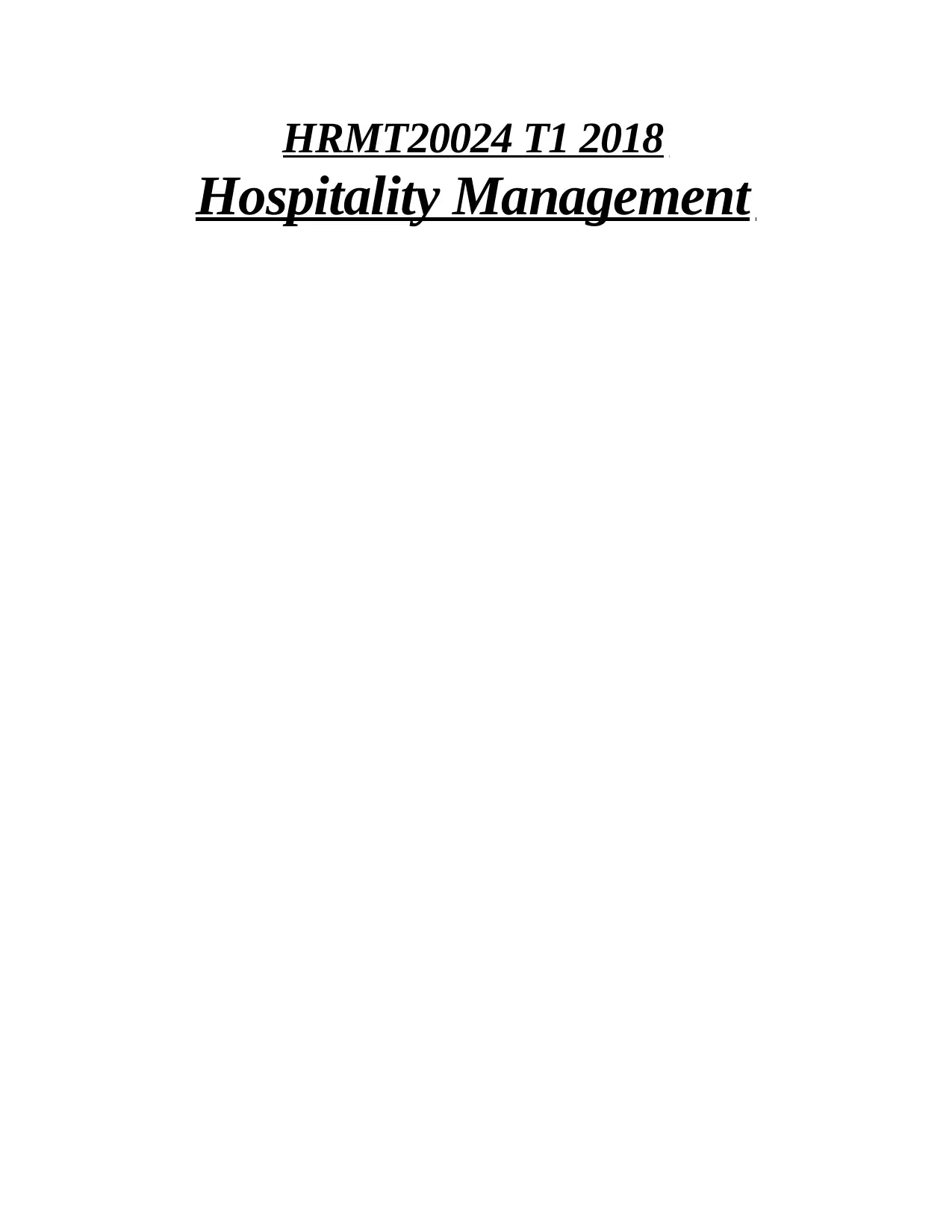
HRMT20024 T1 2018
Hospitality Management
Hospitality Management
Paraphrase This Document
Need a fresh take? Get an instant paraphrase of this document with our AI Paraphraser
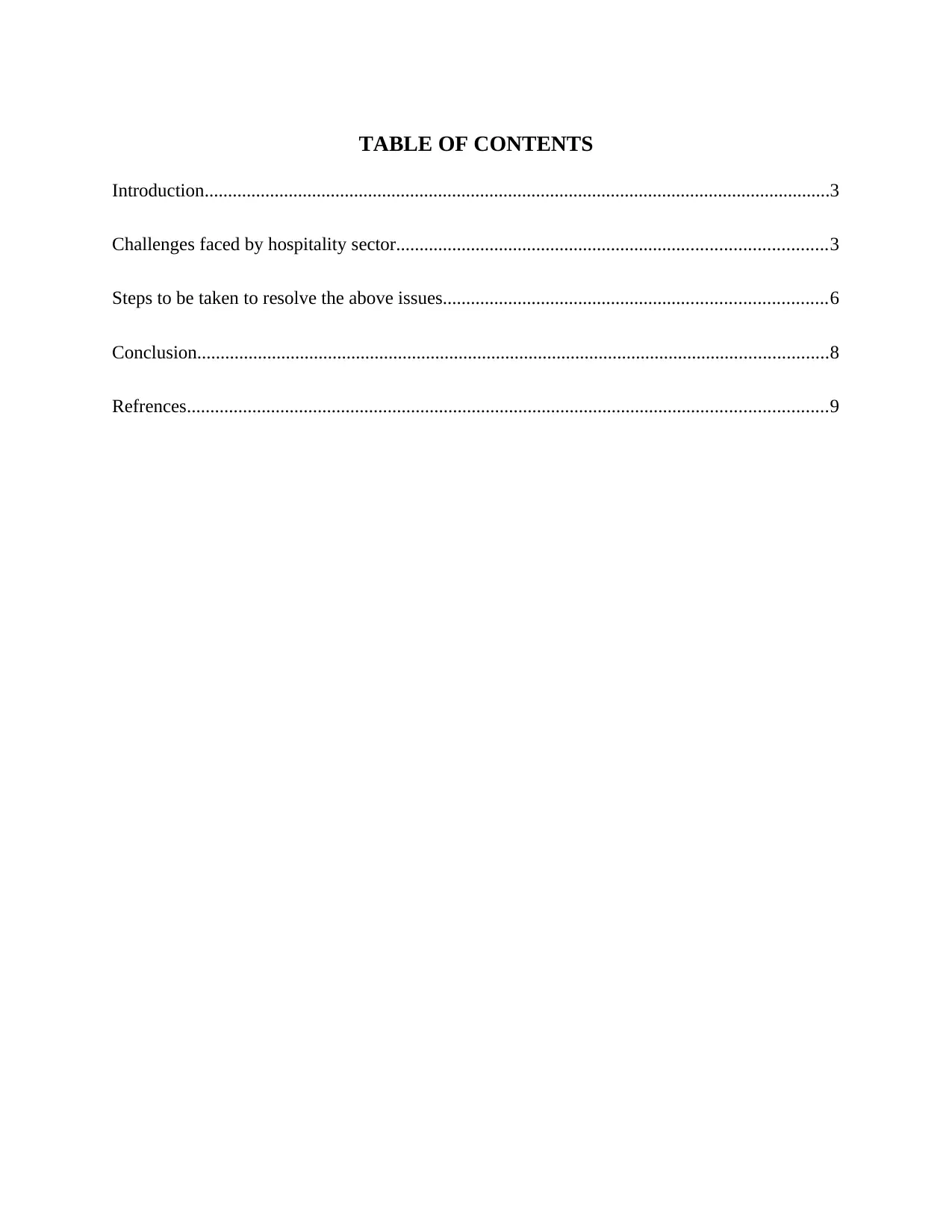
TABLE OF CONTENTS
Introduction......................................................................................................................................3
Challenges faced by hospitality sector............................................................................................3
Steps to be taken to resolve the above issues..................................................................................6
Conclusion.......................................................................................................................................8
Refrences.........................................................................................................................................9
Introduction......................................................................................................................................3
Challenges faced by hospitality sector............................................................................................3
Steps to be taken to resolve the above issues..................................................................................6
Conclusion.......................................................................................................................................8
Refrences.........................................................................................................................................9
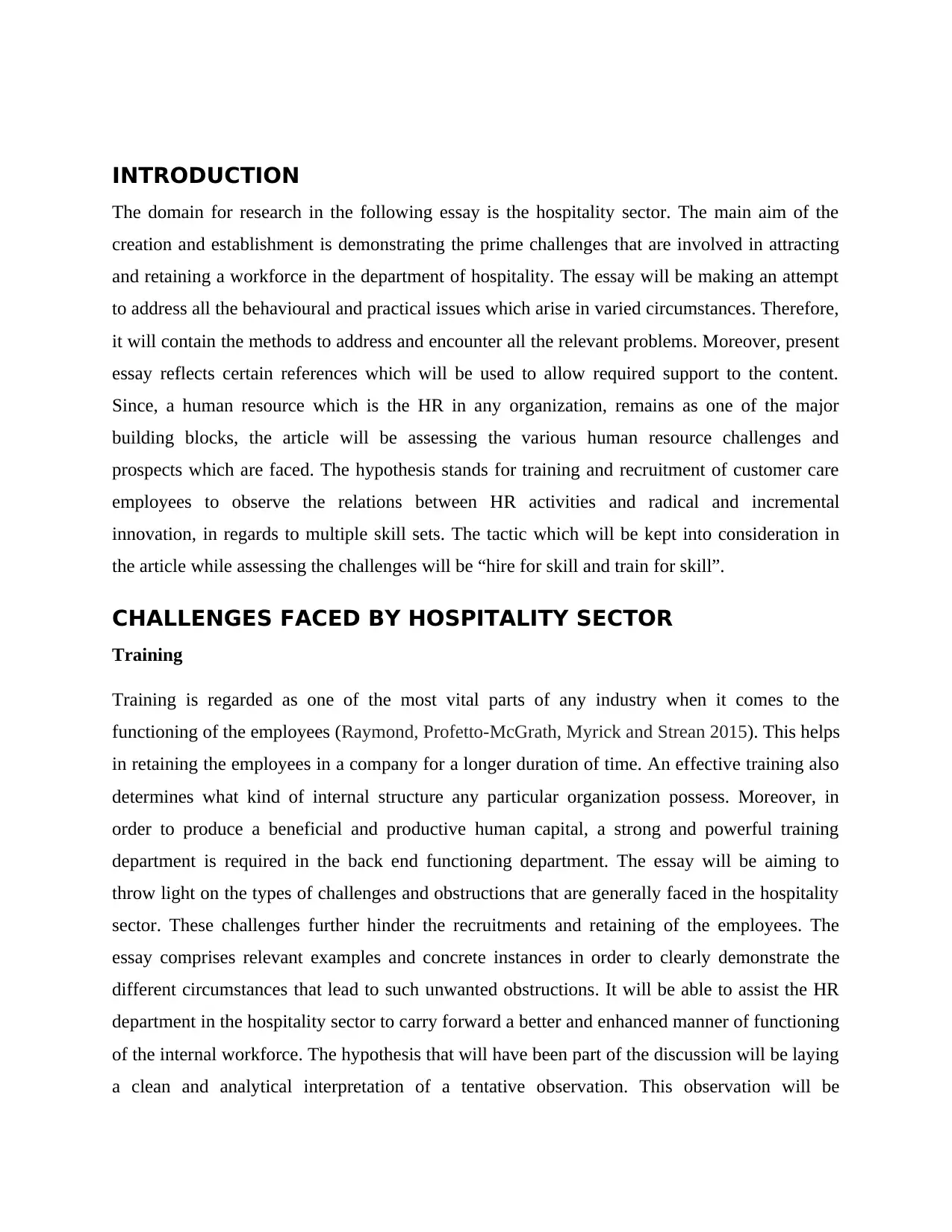
INTRODUCTION
The domain for research in the following essay is the hospitality sector. The main aim of the
creation and establishment is demonstrating the prime challenges that are involved in attracting
and retaining a workforce in the department of hospitality. The essay will be making an attempt
to address all the behavioural and practical issues which arise in varied circumstances. Therefore,
it will contain the methods to address and encounter all the relevant problems. Moreover, present
essay reflects certain references which will be used to allow required support to the content.
Since, a human resource which is the HR in any organization, remains as one of the major
building blocks, the article will be assessing the various human resource challenges and
prospects which are faced. The hypothesis stands for training and recruitment of customer care
employees to observe the relations between HR activities and radical and incremental
innovation, in regards to multiple skill sets. The tactic which will be kept into consideration in
the article while assessing the challenges will be “hire for skill and train for skill”.
CHALLENGES FACED BY HOSPITALITY SECTOR
Training
Training is regarded as one of the most vital parts of any industry when it comes to the
functioning of the employees (Raymond, Profetto-McGrath, Myrick and Strean 2015). This helps
in retaining the employees in a company for a longer duration of time. An effective training also
determines what kind of internal structure any particular organization possess. Moreover, in
order to produce a beneficial and productive human capital, a strong and powerful training
department is required in the back end functioning department. The essay will be aiming to
throw light on the types of challenges and obstructions that are generally faced in the hospitality
sector. These challenges further hinder the recruitments and retaining of the employees. The
essay comprises relevant examples and concrete instances in order to clearly demonstrate the
different circumstances that lead to such unwanted obstructions. It will be able to assist the HR
department in the hospitality sector to carry forward a better and enhanced manner of functioning
of the internal workforce. The hypothesis that will have been part of the discussion will be laying
a clean and analytical interpretation of a tentative observation. This observation will be
The domain for research in the following essay is the hospitality sector. The main aim of the
creation and establishment is demonstrating the prime challenges that are involved in attracting
and retaining a workforce in the department of hospitality. The essay will be making an attempt
to address all the behavioural and practical issues which arise in varied circumstances. Therefore,
it will contain the methods to address and encounter all the relevant problems. Moreover, present
essay reflects certain references which will be used to allow required support to the content.
Since, a human resource which is the HR in any organization, remains as one of the major
building blocks, the article will be assessing the various human resource challenges and
prospects which are faced. The hypothesis stands for training and recruitment of customer care
employees to observe the relations between HR activities and radical and incremental
innovation, in regards to multiple skill sets. The tactic which will be kept into consideration in
the article while assessing the challenges will be “hire for skill and train for skill”.
CHALLENGES FACED BY HOSPITALITY SECTOR
Training
Training is regarded as one of the most vital parts of any industry when it comes to the
functioning of the employees (Raymond, Profetto-McGrath, Myrick and Strean 2015). This helps
in retaining the employees in a company for a longer duration of time. An effective training also
determines what kind of internal structure any particular organization possess. Moreover, in
order to produce a beneficial and productive human capital, a strong and powerful training
department is required in the back end functioning department. The essay will be aiming to
throw light on the types of challenges and obstructions that are generally faced in the hospitality
sector. These challenges further hinder the recruitments and retaining of the employees. The
essay comprises relevant examples and concrete instances in order to clearly demonstrate the
different circumstances that lead to such unwanted obstructions. It will be able to assist the HR
department in the hospitality sector to carry forward a better and enhanced manner of functioning
of the internal workforce. The hypothesis that will have been part of the discussion will be laying
a clean and analytical interpretation of a tentative observation. This observation will be
You're viewing a preview
Unlock full access by subscribing today!
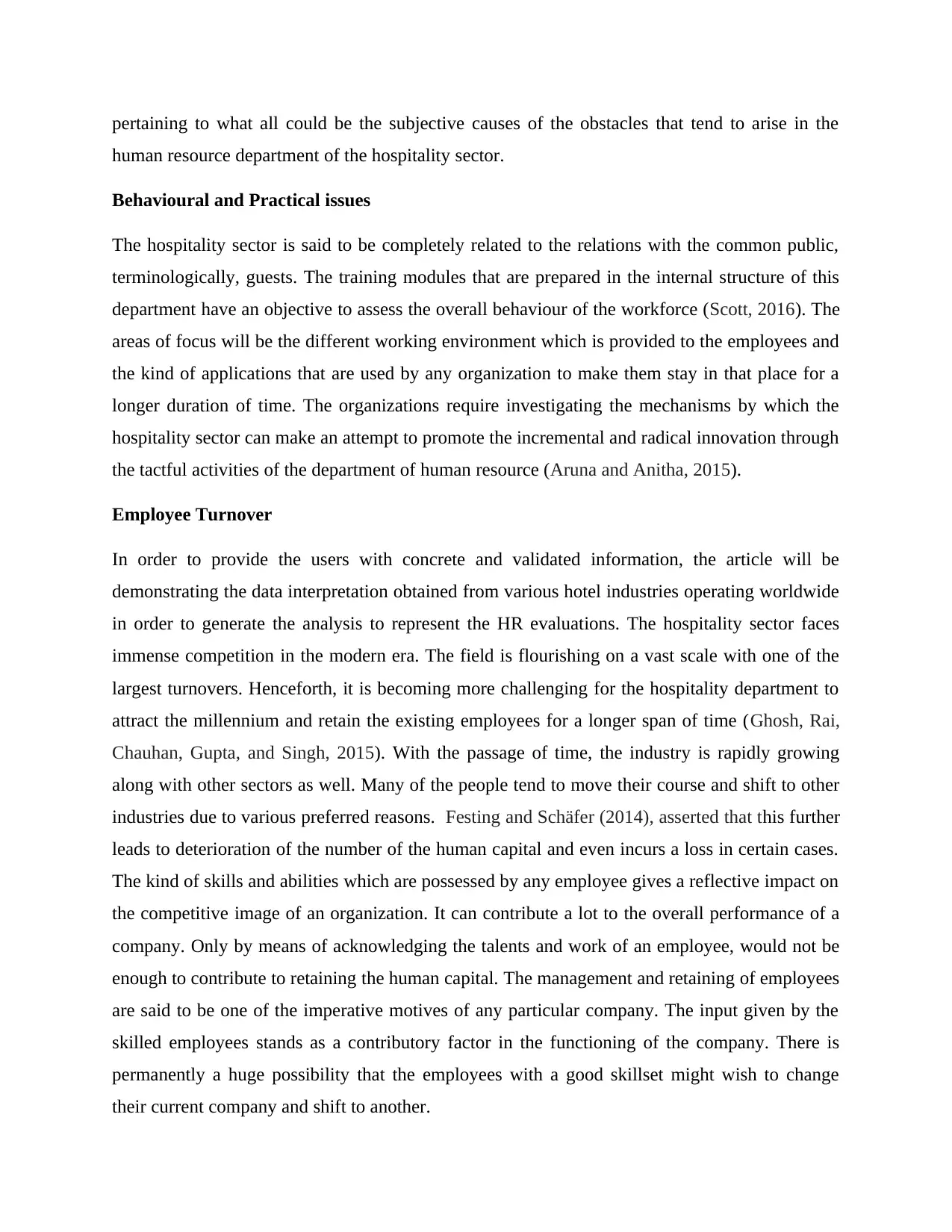
pertaining to what all could be the subjective causes of the obstacles that tend to arise in the
human resource department of the hospitality sector.
Behavioural and Practical issues
The hospitality sector is said to be completely related to the relations with the common public,
terminologically, guests. The training modules that are prepared in the internal structure of this
department have an objective to assess the overall behaviour of the workforce (Scott, 2016). The
areas of focus will be the different working environment which is provided to the employees and
the kind of applications that are used by any organization to make them stay in that place for a
longer duration of time. The organizations require investigating the mechanisms by which the
hospitality sector can make an attempt to promote the incremental and radical innovation through
the tactful activities of the department of human resource (Aruna and Anitha, 2015).
Employee Turnover
In order to provide the users with concrete and validated information, the article will be
demonstrating the data interpretation obtained from various hotel industries operating worldwide
in order to generate the analysis to represent the HR evaluations. The hospitality sector faces
immense competition in the modern era. The field is flourishing on a vast scale with one of the
largest turnovers. Henceforth, it is becoming more challenging for the hospitality department to
attract the millennium and retain the existing employees for a longer span of time (Ghosh, Rai,
Chauhan, Gupta, and Singh, 2015). With the passage of time, the industry is rapidly growing
along with other sectors as well. Many of the people tend to move their course and shift to other
industries due to various preferred reasons. Festing and Schäfer (2014), asserted that this further
leads to deterioration of the number of the human capital and even incurs a loss in certain cases.
The kind of skills and abilities which are possessed by any employee gives a reflective impact on
the competitive image of an organization. It can contribute a lot to the overall performance of a
company. Only by means of acknowledging the talents and work of an employee, would not be
enough to contribute to retaining the human capital. The management and retaining of employees
are said to be one of the imperative motives of any particular company. The input given by the
skilled employees stands as a contributory factor in the functioning of the company. There is
permanently a huge possibility that the employees with a good skillset might wish to change
their current company and shift to another.
human resource department of the hospitality sector.
Behavioural and Practical issues
The hospitality sector is said to be completely related to the relations with the common public,
terminologically, guests. The training modules that are prepared in the internal structure of this
department have an objective to assess the overall behaviour of the workforce (Scott, 2016). The
areas of focus will be the different working environment which is provided to the employees and
the kind of applications that are used by any organization to make them stay in that place for a
longer duration of time. The organizations require investigating the mechanisms by which the
hospitality sector can make an attempt to promote the incremental and radical innovation through
the tactful activities of the department of human resource (Aruna and Anitha, 2015).
Employee Turnover
In order to provide the users with concrete and validated information, the article will be
demonstrating the data interpretation obtained from various hotel industries operating worldwide
in order to generate the analysis to represent the HR evaluations. The hospitality sector faces
immense competition in the modern era. The field is flourishing on a vast scale with one of the
largest turnovers. Henceforth, it is becoming more challenging for the hospitality department to
attract the millennium and retain the existing employees for a longer span of time (Ghosh, Rai,
Chauhan, Gupta, and Singh, 2015). With the passage of time, the industry is rapidly growing
along with other sectors as well. Many of the people tend to move their course and shift to other
industries due to various preferred reasons. Festing and Schäfer (2014), asserted that this further
leads to deterioration of the number of the human capital and even incurs a loss in certain cases.
The kind of skills and abilities which are possessed by any employee gives a reflective impact on
the competitive image of an organization. It can contribute a lot to the overall performance of a
company. Only by means of acknowledging the talents and work of an employee, would not be
enough to contribute to retaining the human capital. The management and retaining of employees
are said to be one of the imperative motives of any particular company. The input given by the
skilled employees stands as a contributory factor in the functioning of the company. There is
permanently a huge possibility that the employees with a good skillset might wish to change
their current company and shift to another.
Paraphrase This Document
Need a fresh take? Get an instant paraphrase of this document with our AI Paraphraser
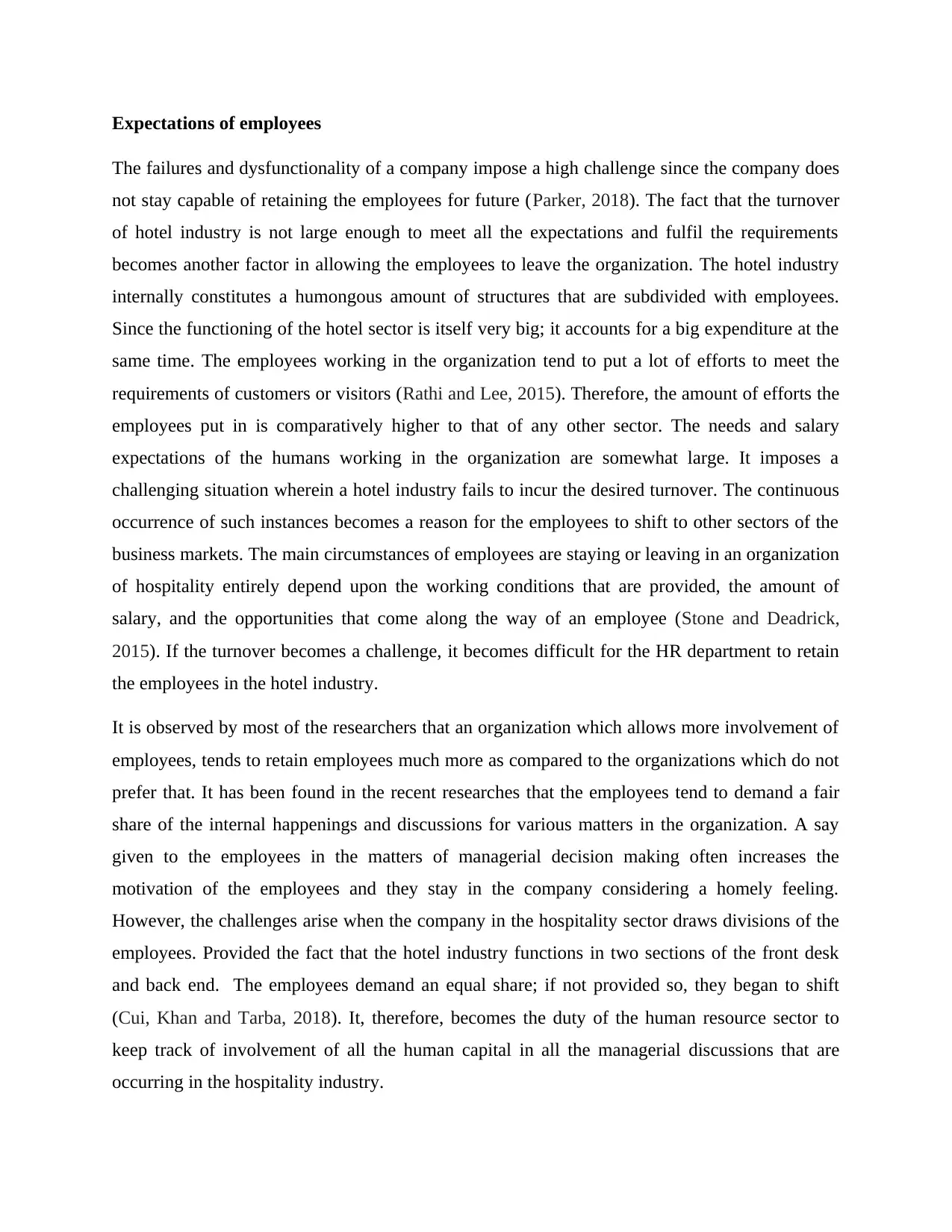
Expectations of employees
The failures and dysfunctionality of a company impose a high challenge since the company does
not stay capable of retaining the employees for future (Parker, 2018). The fact that the turnover
of hotel industry is not large enough to meet all the expectations and fulfil the requirements
becomes another factor in allowing the employees to leave the organization. The hotel industry
internally constitutes a humongous amount of structures that are subdivided with employees.
Since the functioning of the hotel sector is itself very big; it accounts for a big expenditure at the
same time. The employees working in the organization tend to put a lot of efforts to meet the
requirements of customers or visitors (Rathi and Lee, 2015). Therefore, the amount of efforts the
employees put in is comparatively higher to that of any other sector. The needs and salary
expectations of the humans working in the organization are somewhat large. It imposes a
challenging situation wherein a hotel industry fails to incur the desired turnover. The continuous
occurrence of such instances becomes a reason for the employees to shift to other sectors of the
business markets. The main circumstances of employees are staying or leaving in an organization
of hospitality entirely depend upon the working conditions that are provided, the amount of
salary, and the opportunities that come along the way of an employee (Stone and Deadrick,
2015). If the turnover becomes a challenge, it becomes difficult for the HR department to retain
the employees in the hotel industry.
It is observed by most of the researchers that an organization which allows more involvement of
employees, tends to retain employees much more as compared to the organizations which do not
prefer that. It has been found in the recent researches that the employees tend to demand a fair
share of the internal happenings and discussions for various matters in the organization. A say
given to the employees in the matters of managerial decision making often increases the
motivation of the employees and they stay in the company considering a homely feeling.
However, the challenges arise when the company in the hospitality sector draws divisions of the
employees. Provided the fact that the hotel industry functions in two sections of the front desk
and back end. The employees demand an equal share; if not provided so, they began to shift
(Cui, Khan and Tarba, 2018). It, therefore, becomes the duty of the human resource sector to
keep track of involvement of all the human capital in all the managerial discussions that are
occurring in the hospitality industry.
The failures and dysfunctionality of a company impose a high challenge since the company does
not stay capable of retaining the employees for future (Parker, 2018). The fact that the turnover
of hotel industry is not large enough to meet all the expectations and fulfil the requirements
becomes another factor in allowing the employees to leave the organization. The hotel industry
internally constitutes a humongous amount of structures that are subdivided with employees.
Since the functioning of the hotel sector is itself very big; it accounts for a big expenditure at the
same time. The employees working in the organization tend to put a lot of efforts to meet the
requirements of customers or visitors (Rathi and Lee, 2015). Therefore, the amount of efforts the
employees put in is comparatively higher to that of any other sector. The needs and salary
expectations of the humans working in the organization are somewhat large. It imposes a
challenging situation wherein a hotel industry fails to incur the desired turnover. The continuous
occurrence of such instances becomes a reason for the employees to shift to other sectors of the
business markets. The main circumstances of employees are staying or leaving in an organization
of hospitality entirely depend upon the working conditions that are provided, the amount of
salary, and the opportunities that come along the way of an employee (Stone and Deadrick,
2015). If the turnover becomes a challenge, it becomes difficult for the HR department to retain
the employees in the hotel industry.
It is observed by most of the researchers that an organization which allows more involvement of
employees, tends to retain employees much more as compared to the organizations which do not
prefer that. It has been found in the recent researches that the employees tend to demand a fair
share of the internal happenings and discussions for various matters in the organization. A say
given to the employees in the matters of managerial decision making often increases the
motivation of the employees and they stay in the company considering a homely feeling.
However, the challenges arise when the company in the hospitality sector draws divisions of the
employees. Provided the fact that the hotel industry functions in two sections of the front desk
and back end. The employees demand an equal share; if not provided so, they began to shift
(Cui, Khan and Tarba, 2018). It, therefore, becomes the duty of the human resource sector to
keep track of involvement of all the human capital in all the managerial discussions that are
occurring in the hospitality industry.
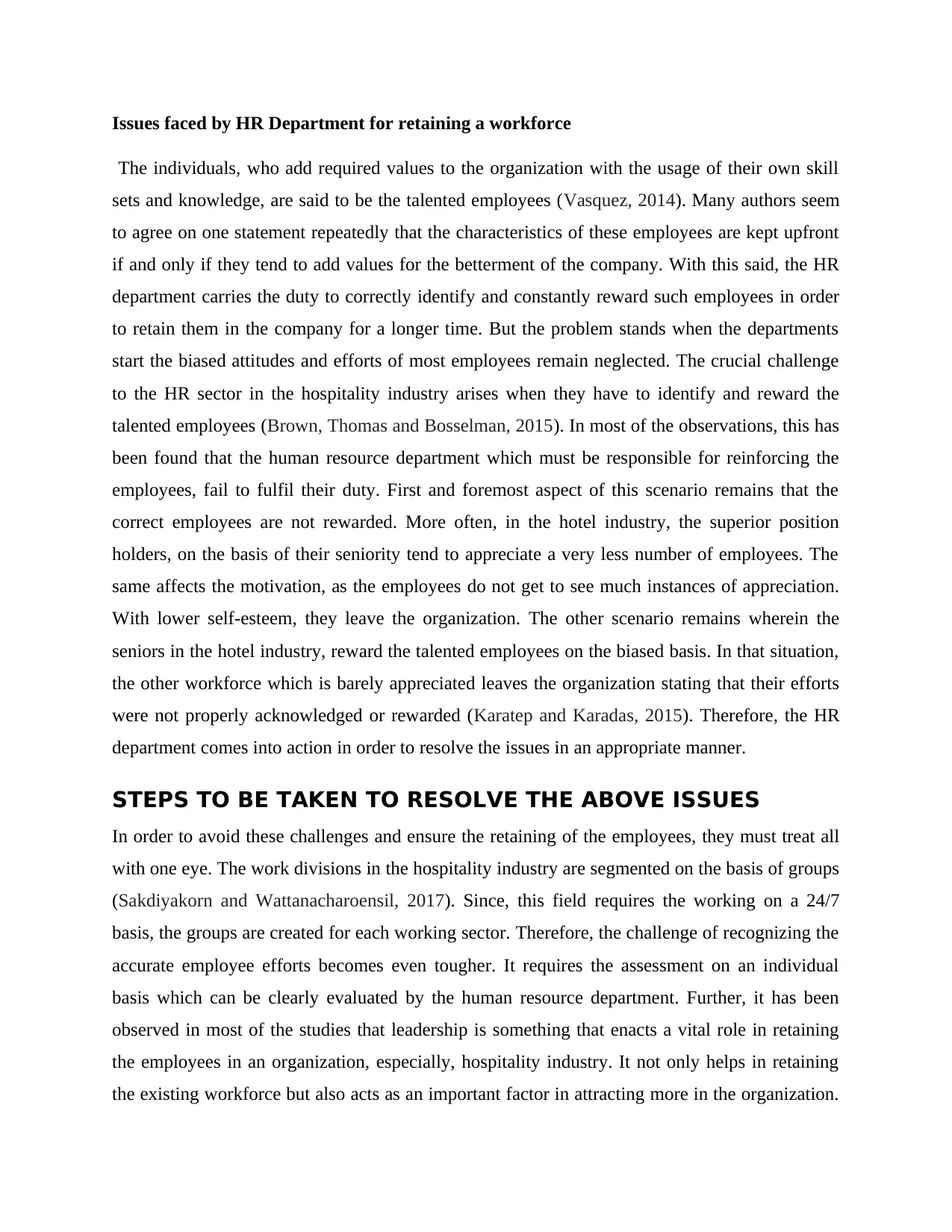
Issues faced by HR Department for retaining a workforce
The individuals, who add required values to the organization with the usage of their own skill
sets and knowledge, are said to be the talented employees (Vasquez, 2014). Many authors seem
to agree on one statement repeatedly that the characteristics of these employees are kept upfront
if and only if they tend to add values for the betterment of the company. With this said, the HR
department carries the duty to correctly identify and constantly reward such employees in order
to retain them in the company for a longer time. But the problem stands when the departments
start the biased attitudes and efforts of most employees remain neglected. The crucial challenge
to the HR sector in the hospitality industry arises when they have to identify and reward the
talented employees (Brown, Thomas and Bosselman, 2015). In most of the observations, this has
been found that the human resource department which must be responsible for reinforcing the
employees, fail to fulfil their duty. First and foremost aspect of this scenario remains that the
correct employees are not rewarded. More often, in the hotel industry, the superior position
holders, on the basis of their seniority tend to appreciate a very less number of employees. The
same affects the motivation, as the employees do not get to see much instances of appreciation.
With lower self-esteem, they leave the organization. The other scenario remains wherein the
seniors in the hotel industry, reward the talented employees on the biased basis. In that situation,
the other workforce which is barely appreciated leaves the organization stating that their efforts
were not properly acknowledged or rewarded (Karatep and Karadas, 2015). Therefore, the HR
department comes into action in order to resolve the issues in an appropriate manner.
STEPS TO BE TAKEN TO RESOLVE THE ABOVE ISSUES
In order to avoid these challenges and ensure the retaining of the employees, they must treat all
with one eye. The work divisions in the hospitality industry are segmented on the basis of groups
(Sakdiyakorn and Wattanacharoensil, 2017). Since, this field requires the working on a 24/7
basis, the groups are created for each working sector. Therefore, the challenge of recognizing the
accurate employee efforts becomes even tougher. It requires the assessment on an individual
basis which can be clearly evaluated by the human resource department. Further, it has been
observed in most of the studies that leadership is something that enacts a vital role in retaining
the employees in an organization, especially, hospitality industry. It not only helps in retaining
the existing workforce but also acts as an important factor in attracting more in the organization.
The individuals, who add required values to the organization with the usage of their own skill
sets and knowledge, are said to be the talented employees (Vasquez, 2014). Many authors seem
to agree on one statement repeatedly that the characteristics of these employees are kept upfront
if and only if they tend to add values for the betterment of the company. With this said, the HR
department carries the duty to correctly identify and constantly reward such employees in order
to retain them in the company for a longer time. But the problem stands when the departments
start the biased attitudes and efforts of most employees remain neglected. The crucial challenge
to the HR sector in the hospitality industry arises when they have to identify and reward the
talented employees (Brown, Thomas and Bosselman, 2015). In most of the observations, this has
been found that the human resource department which must be responsible for reinforcing the
employees, fail to fulfil their duty. First and foremost aspect of this scenario remains that the
correct employees are not rewarded. More often, in the hotel industry, the superior position
holders, on the basis of their seniority tend to appreciate a very less number of employees. The
same affects the motivation, as the employees do not get to see much instances of appreciation.
With lower self-esteem, they leave the organization. The other scenario remains wherein the
seniors in the hotel industry, reward the talented employees on the biased basis. In that situation,
the other workforce which is barely appreciated leaves the organization stating that their efforts
were not properly acknowledged or rewarded (Karatep and Karadas, 2015). Therefore, the HR
department comes into action in order to resolve the issues in an appropriate manner.
STEPS TO BE TAKEN TO RESOLVE THE ABOVE ISSUES
In order to avoid these challenges and ensure the retaining of the employees, they must treat all
with one eye. The work divisions in the hospitality industry are segmented on the basis of groups
(Sakdiyakorn and Wattanacharoensil, 2017). Since, this field requires the working on a 24/7
basis, the groups are created for each working sector. Therefore, the challenge of recognizing the
accurate employee efforts becomes even tougher. It requires the assessment on an individual
basis which can be clearly evaluated by the human resource department. Further, it has been
observed in most of the studies that leadership is something that enacts a vital role in retaining
the employees in an organization, especially, hospitality industry. It not only helps in retaining
the existing workforce but also acts as an important factor in attracting more in the organization.
You're viewing a preview
Unlock full access by subscribing today!
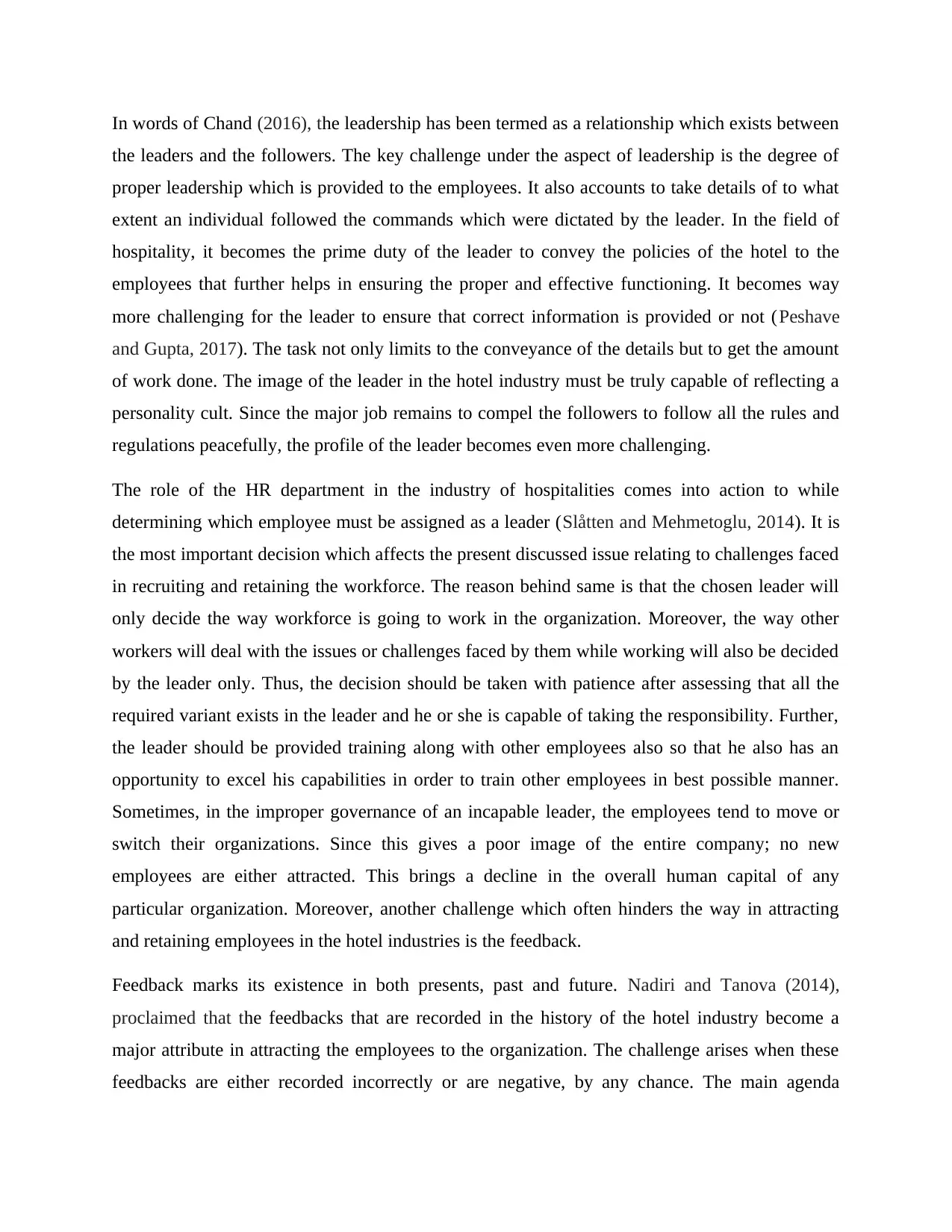
In words of Chand (2016), the leadership has been termed as a relationship which exists between
the leaders and the followers. The key challenge under the aspect of leadership is the degree of
proper leadership which is provided to the employees. It also accounts to take details of to what
extent an individual followed the commands which were dictated by the leader. In the field of
hospitality, it becomes the prime duty of the leader to convey the policies of the hotel to the
employees that further helps in ensuring the proper and effective functioning. It becomes way
more challenging for the leader to ensure that correct information is provided or not (Peshave
and Gupta, 2017). The task not only limits to the conveyance of the details but to get the amount
of work done. The image of the leader in the hotel industry must be truly capable of reflecting a
personality cult. Since the major job remains to compel the followers to follow all the rules and
regulations peacefully, the profile of the leader becomes even more challenging.
The role of the HR department in the industry of hospitalities comes into action to while
determining which employee must be assigned as a leader (Slåtten and Mehmetoglu, 2014). It is
the most important decision which affects the present discussed issue relating to challenges faced
in recruiting and retaining the workforce. The reason behind same is that the chosen leader will
only decide the way workforce is going to work in the organization. Moreover, the way other
workers will deal with the issues or challenges faced by them while working will also be decided
by the leader only. Thus, the decision should be taken with patience after assessing that all the
required variant exists in the leader and he or she is capable of taking the responsibility. Further,
the leader should be provided training along with other employees also so that he also has an
opportunity to excel his capabilities in order to train other employees in best possible manner.
Sometimes, in the improper governance of an incapable leader, the employees tend to move or
switch their organizations. Since this gives a poor image of the entire company; no new
employees are either attracted. This brings a decline in the overall human capital of any
particular organization. Moreover, another challenge which often hinders the way in attracting
and retaining employees in the hotel industries is the feedback.
Feedback marks its existence in both presents, past and future. Nadiri and Tanova (2014),
proclaimed that the feedbacks that are recorded in the history of the hotel industry become a
major attribute in attracting the employees to the organization. The challenge arises when these
feedbacks are either recorded incorrectly or are negative, by any chance. The main agenda
the leaders and the followers. The key challenge under the aspect of leadership is the degree of
proper leadership which is provided to the employees. It also accounts to take details of to what
extent an individual followed the commands which were dictated by the leader. In the field of
hospitality, it becomes the prime duty of the leader to convey the policies of the hotel to the
employees that further helps in ensuring the proper and effective functioning. It becomes way
more challenging for the leader to ensure that correct information is provided or not (Peshave
and Gupta, 2017). The task not only limits to the conveyance of the details but to get the amount
of work done. The image of the leader in the hotel industry must be truly capable of reflecting a
personality cult. Since the major job remains to compel the followers to follow all the rules and
regulations peacefully, the profile of the leader becomes even more challenging.
The role of the HR department in the industry of hospitalities comes into action to while
determining which employee must be assigned as a leader (Slåtten and Mehmetoglu, 2014). It is
the most important decision which affects the present discussed issue relating to challenges faced
in recruiting and retaining the workforce. The reason behind same is that the chosen leader will
only decide the way workforce is going to work in the organization. Moreover, the way other
workers will deal with the issues or challenges faced by them while working will also be decided
by the leader only. Thus, the decision should be taken with patience after assessing that all the
required variant exists in the leader and he or she is capable of taking the responsibility. Further,
the leader should be provided training along with other employees also so that he also has an
opportunity to excel his capabilities in order to train other employees in best possible manner.
Sometimes, in the improper governance of an incapable leader, the employees tend to move or
switch their organizations. Since this gives a poor image of the entire company; no new
employees are either attracted. This brings a decline in the overall human capital of any
particular organization. Moreover, another challenge which often hinders the way in attracting
and retaining employees in the hotel industries is the feedback.
Feedback marks its existence in both presents, past and future. Nadiri and Tanova (2014),
proclaimed that the feedbacks that are recorded in the history of the hotel industry become a
major attribute in attracting the employees to the organization. The challenge arises when these
feedbacks are either recorded incorrectly or are negative, by any chance. The main agenda
Paraphrase This Document
Need a fresh take? Get an instant paraphrase of this document with our AI Paraphraser

behind feedback is to support the learning of an individual. The challenges come in the way
when the employees are asked to give feedback. They enact an important role to evaluate the
annual performance of the hospitality industry. The feedbacks in any organization are obtained
by means of the human resource department. Many employees keep a belief in assessing the
annual report of feedbacks that are received. They leave the organization in the cases wherein the
feedbacks are negative in a belief of shifting to a better organization.
CONCLUSION
The present study shows that, both the intrinsic and extrinsic factors play a key role in the
retention and attraction of employees in the hospitality industry. In order to encounter the
challenges in the present study and eliminate them from the root, the field is required to imply
strategies for betterment. It is solely about the authenticity of the industry and the manner in
which it is represented both internally and externally. The policies and reinforcing strategies of
the hotel industries must be tailored in such a way that it begins to appeal to the employees. The
internal policies for the functioning of the employees must be carried out in a manner which will
be able to satisfy the needs. The importance of engagement of employees contributes a major
part towards the elimination of the observed challenges. It accounts to provide importance to the
employees and increases motivation. It can be concluded from above discussion that flexible
regulations further helps in attracting more and more workforce to the particular organization. A
positive feedbacks helps in reflecting a much positive image of the company in the outside world
that helps in inviting more people to the organization. Therefore, the company’s main focus in
the hospitality industry must be laid towards a proper structuring internally to keep maintaining a
productive position with maintenance and retention of the employees. Ignoring petty factors
leads to huge unwanted circumstances particularly in the hospitality industry. For the same
course, the human resource department must have a strong action strategy to generalize all the
challenges and account it for the required solutions.
when the employees are asked to give feedback. They enact an important role to evaluate the
annual performance of the hospitality industry. The feedbacks in any organization are obtained
by means of the human resource department. Many employees keep a belief in assessing the
annual report of feedbacks that are received. They leave the organization in the cases wherein the
feedbacks are negative in a belief of shifting to a better organization.
CONCLUSION
The present study shows that, both the intrinsic and extrinsic factors play a key role in the
retention and attraction of employees in the hospitality industry. In order to encounter the
challenges in the present study and eliminate them from the root, the field is required to imply
strategies for betterment. It is solely about the authenticity of the industry and the manner in
which it is represented both internally and externally. The policies and reinforcing strategies of
the hotel industries must be tailored in such a way that it begins to appeal to the employees. The
internal policies for the functioning of the employees must be carried out in a manner which will
be able to satisfy the needs. The importance of engagement of employees contributes a major
part towards the elimination of the observed challenges. It accounts to provide importance to the
employees and increases motivation. It can be concluded from above discussion that flexible
regulations further helps in attracting more and more workforce to the particular organization. A
positive feedbacks helps in reflecting a much positive image of the company in the outside world
that helps in inviting more people to the organization. Therefore, the company’s main focus in
the hospitality industry must be laid towards a proper structuring internally to keep maintaining a
productive position with maintenance and retention of the employees. Ignoring petty factors
leads to huge unwanted circumstances particularly in the hospitality industry. For the same
course, the human resource department must have a strong action strategy to generalize all the
challenges and account it for the required solutions.
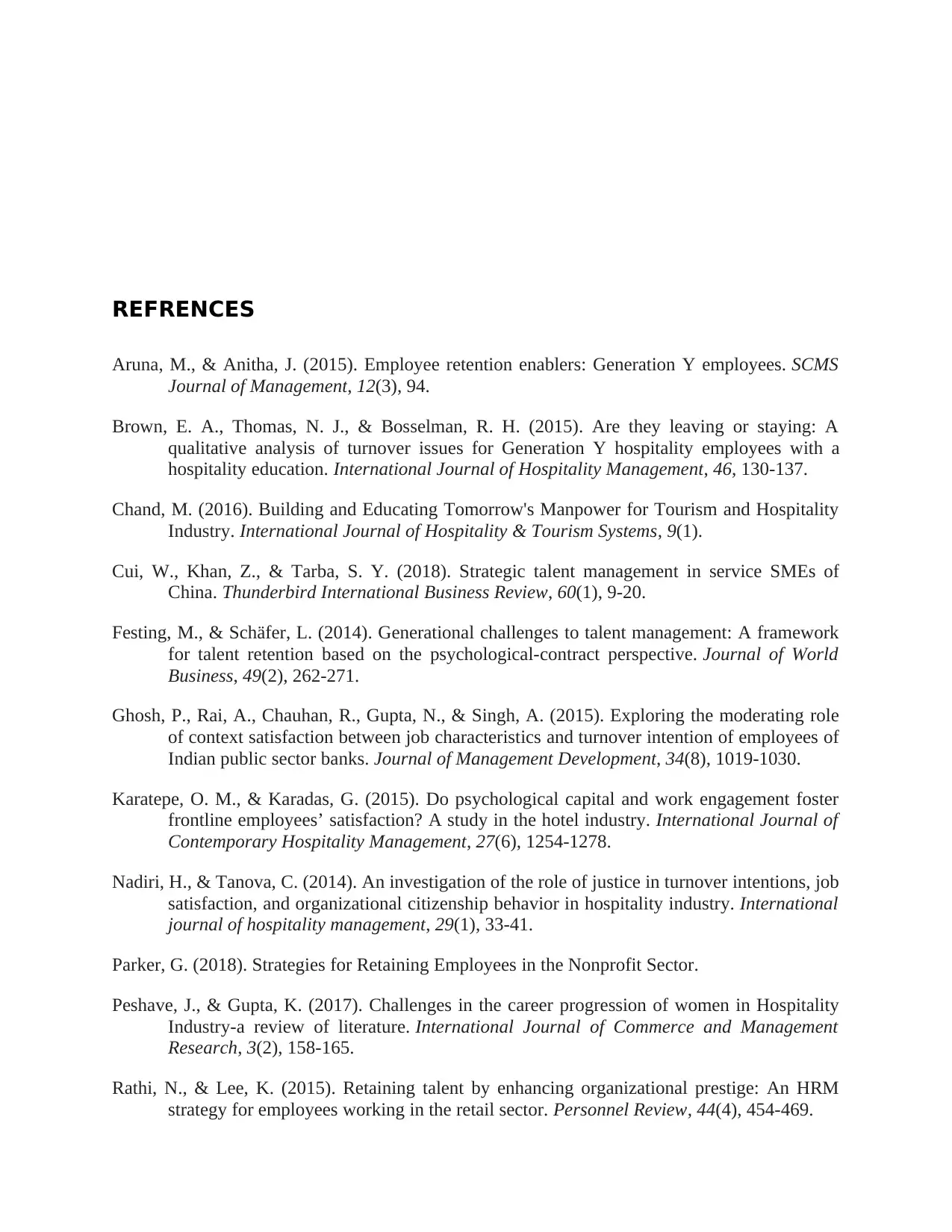
REFRENCES
Aruna, M., & Anitha, J. (2015). Employee retention enablers: Generation Y employees. SCMS
Journal of Management, 12(3), 94.
Brown, E. A., Thomas, N. J., & Bosselman, R. H. (2015). Are they leaving or staying: A
qualitative analysis of turnover issues for Generation Y hospitality employees with a
hospitality education. International Journal of Hospitality Management, 46, 130-137.
Chand, M. (2016). Building and Educating Tomorrow's Manpower for Tourism and Hospitality
Industry. International Journal of Hospitality & Tourism Systems, 9(1).
Cui, W., Khan, Z., & Tarba, S. Y. (2018). Strategic talent management in service SMEs of
China. Thunderbird International Business Review, 60(1), 9-20.
Festing, M., & Schäfer, L. (2014). Generational challenges to talent management: A framework
for talent retention based on the psychological-contract perspective. Journal of World
Business, 49(2), 262-271.
Ghosh, P., Rai, A., Chauhan, R., Gupta, N., & Singh, A. (2015). Exploring the moderating role
of context satisfaction between job characteristics and turnover intention of employees of
Indian public sector banks. Journal of Management Development, 34(8), 1019-1030.
Karatepe, O. M., & Karadas, G. (2015). Do psychological capital and work engagement foster
frontline employees’ satisfaction? A study in the hotel industry. International Journal of
Contemporary Hospitality Management, 27(6), 1254-1278.
Nadiri, H., & Tanova, C. (2014). An investigation of the role of justice in turnover intentions, job
satisfaction, and organizational citizenship behavior in hospitality industry. International
journal of hospitality management, 29(1), 33-41.
Parker, G. (2018). Strategies for Retaining Employees in the Nonprofit Sector.
Peshave, J., & Gupta, K. (2017). Challenges in the career progression of women in Hospitality
Industry-a review of literature. International Journal of Commerce and Management
Research, 3(2), 158-165.
Rathi, N., & Lee, K. (2015). Retaining talent by enhancing organizational prestige: An HRM
strategy for employees working in the retail sector. Personnel Review, 44(4), 454-469.
Aruna, M., & Anitha, J. (2015). Employee retention enablers: Generation Y employees. SCMS
Journal of Management, 12(3), 94.
Brown, E. A., Thomas, N. J., & Bosselman, R. H. (2015). Are they leaving or staying: A
qualitative analysis of turnover issues for Generation Y hospitality employees with a
hospitality education. International Journal of Hospitality Management, 46, 130-137.
Chand, M. (2016). Building and Educating Tomorrow's Manpower for Tourism and Hospitality
Industry. International Journal of Hospitality & Tourism Systems, 9(1).
Cui, W., Khan, Z., & Tarba, S. Y. (2018). Strategic talent management in service SMEs of
China. Thunderbird International Business Review, 60(1), 9-20.
Festing, M., & Schäfer, L. (2014). Generational challenges to talent management: A framework
for talent retention based on the psychological-contract perspective. Journal of World
Business, 49(2), 262-271.
Ghosh, P., Rai, A., Chauhan, R., Gupta, N., & Singh, A. (2015). Exploring the moderating role
of context satisfaction between job characteristics and turnover intention of employees of
Indian public sector banks. Journal of Management Development, 34(8), 1019-1030.
Karatepe, O. M., & Karadas, G. (2015). Do psychological capital and work engagement foster
frontline employees’ satisfaction? A study in the hotel industry. International Journal of
Contemporary Hospitality Management, 27(6), 1254-1278.
Nadiri, H., & Tanova, C. (2014). An investigation of the role of justice in turnover intentions, job
satisfaction, and organizational citizenship behavior in hospitality industry. International
journal of hospitality management, 29(1), 33-41.
Parker, G. (2018). Strategies for Retaining Employees in the Nonprofit Sector.
Peshave, J., & Gupta, K. (2017). Challenges in the career progression of women in Hospitality
Industry-a review of literature. International Journal of Commerce and Management
Research, 3(2), 158-165.
Rathi, N., & Lee, K. (2015). Retaining talent by enhancing organizational prestige: An HRM
strategy for employees working in the retail sector. Personnel Review, 44(4), 454-469.
You're viewing a preview
Unlock full access by subscribing today!
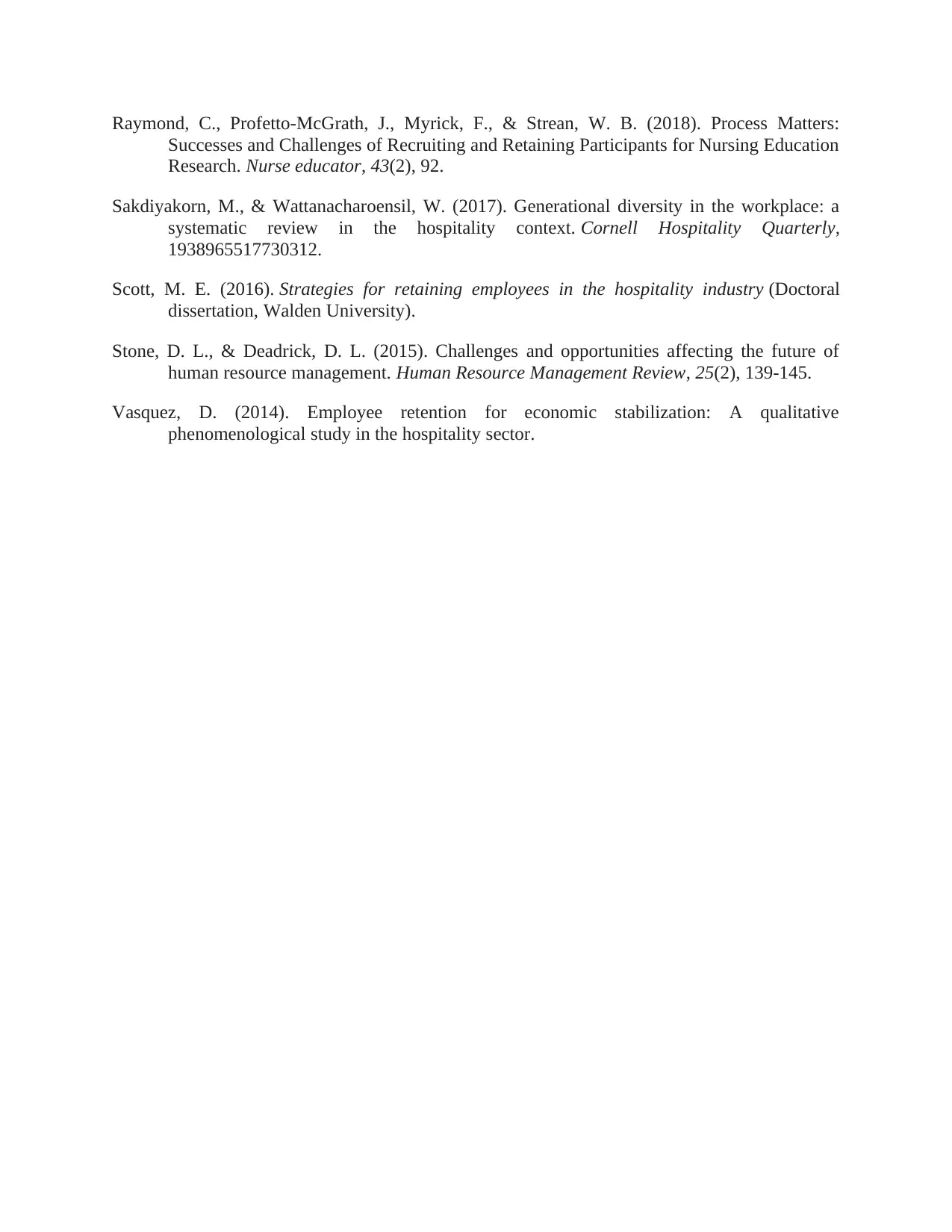
Raymond, C., Profetto-McGrath, J., Myrick, F., & Strean, W. B. (2018). Process Matters:
Successes and Challenges of Recruiting and Retaining Participants for Nursing Education
Research. Nurse educator, 43(2), 92.
Sakdiyakorn, M., & Wattanacharoensil, W. (2017). Generational diversity in the workplace: a
systematic review in the hospitality context. Cornell Hospitality Quarterly,
1938965517730312.
Scott, M. E. (2016). Strategies for retaining employees in the hospitality industry (Doctoral
dissertation, Walden University).
Stone, D. L., & Deadrick, D. L. (2015). Challenges and opportunities affecting the future of
human resource management. Human Resource Management Review, 25(2), 139-145.
Vasquez, D. (2014). Employee retention for economic stabilization: A qualitative
phenomenological study in the hospitality sector.
Successes and Challenges of Recruiting and Retaining Participants for Nursing Education
Research. Nurse educator, 43(2), 92.
Sakdiyakorn, M., & Wattanacharoensil, W. (2017). Generational diversity in the workplace: a
systematic review in the hospitality context. Cornell Hospitality Quarterly,
1938965517730312.
Scott, M. E. (2016). Strategies for retaining employees in the hospitality industry (Doctoral
dissertation, Walden University).
Stone, D. L., & Deadrick, D. L. (2015). Challenges and opportunities affecting the future of
human resource management. Human Resource Management Review, 25(2), 139-145.
Vasquez, D. (2014). Employee retention for economic stabilization: A qualitative
phenomenological study in the hospitality sector.
1 out of 10
Related Documents
Your All-in-One AI-Powered Toolkit for Academic Success.
+13062052269
info@desklib.com
Available 24*7 on WhatsApp / Email
![[object Object]](/_next/static/media/star-bottom.7253800d.svg)
Unlock your academic potential
© 2024 | Zucol Services PVT LTD | All rights reserved.




